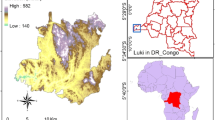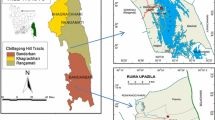Abstract
With the implementation of collective forest tenure reform in China in the 1980s, increasing the area under household forest has great importance in terms of forest production, environmental protection and farmers’ income growth. The scale and usage of household forests is a critical issue that concerns the methods and efficiency of forest management. By conducting a socio-economic survey of 175 households, this paper examines the status of household forestry as well as its utilization in Shangnan County, northern China, and the way in which farmers and their local forest authority interact. Approximately 80 % of households were found to have forest land. Among households which had forestry, nearly half had a forest area of 1 μ (0.07 ha) or less. Fuelwood for household use was the main product of household forests. About 70 % of households regarded fuelwood as their main energy source. Socio-economic factors including financial situation, household size, occupation and educational level of householder were not significantly correlated with the energy choice or the amount of fuelwood consumed. In order to improve the development of household forests, it is necessary to promote better communication between households and forest authorities. The coppice system appears to be a useful forest management strategy because it not only maintains continuous forest cover but also satisfies the high demand for fuelwood in this county.


Similar content being viewed by others

References
Cai ZQ, Ding S, Xie Y, Mi Y, Liu J (2007) Forest-based farmer’s need for forest services and recognition to the service’s supplier—a case study in Fujian Province after the tenure reformation. Issues For Econ 27(6):494–498
Chen JJ, Zhang C (2009) The status and development strategy of fuel wood forest in China. Acta Agric Jiangxi 21(8):169–172
Démurger S, Hou YZ, Yang WY (2009) Forest management policies and resource balance in China: an assessment of the current situation. J Environ Dev 18(1):17–41
Department of Forest Resources Management, SFA (2000) Statistics of national forest resources in China (1994–1998), 21–67
Ellis EA, Porter-Bolland L (2008) Is community-based forest management more effective than protected areas?: a comparison of land use/land cover change in two neighboring study areas of the Central Yucatan Peninsula, Mexico. For Ecol Manag 256(11):1971–1983
Emtage N, Suh J (2004) Socio-economic factors affecting smallholder tree planting and management intentions in Leyte Province, Philippines. Small-scale For Econ Manag Policy 3(2):257–270
Faham E, Rezvanfar A, Shamekhi T (2008) Analysis of socio-economic factors influencing forest dwellers´ participation in reforestation and development of forest areas (the case study of West Mazandaran, Iran). Am J Agric Biol Sci 3(1):438–443
Fang J, Liu G, Xu S (1996) Biomass and net production of forest vegetation in China. Acta Ecol Sin 16(5):497–508
FAO (Food and Agriculture Organization) (2009) State of the world’s forests: global demand for wood products. http://www.fao.org/docrep/011/i0350e/i0350e00.htm
Ho R (2006) Handbook of univariate and multivariate data analysis and interpretation with SPSS. Chapman and Hall/CRC, New York, pp 25–34
Hong ZS, Huang AS (2007) Analysis of the development of privately owned forest in China. China For Econ 84:39–45
Hu JX, Wu ZS (2001) The status and prospective of fuel woodland in Shangnan County. Shaanxi For Sci Tech 3:47–49
Li LY, Chen YH, Liu DD, Ying S, Li L (2004) Farmers’ economic behaviours and forest sustainable management. Issues For Econ 24(4):198–220
Ma WY (1994) A study on the technique of silviculture and management of fuelwood. For Res 7(4):386–393
Matthews JD (1991) Silvicultural systems. Oxford University Press, New York, pp 200–201
Morgan GA, Leech NL, Gloeckner GW, Barrett KC (2011) IBM SPSS for Introductory Statistics: Use and Interpretation, vol 4. Taylor and Francis, New York, pp 109–123
Ndayambaje JD, Heijman WJM, Mohren GMJ (2012) Household determinants of tree planting on farms in rural Rwanda. Small-scale For 11(4):477–508
Northwest Institute of Forest Inventory, Planning and Design, SFA (State Forestry Administration of the People’s Republic of China) (2009). Report on the inventory of forest resources in Shangnan County, Xi’an
Obua J, Banana AY, Turyahabwe N (1998) Attitudes of local communities towards forest management practices in Uganda: the case of Budongo forest reserve. Commonw For Rev 77(2):113–118
Parikka M (2004) Global biomass fuel resources. Biomass Bioenergy 27(6):613–620
Qi MK, Chen H (2008) Study on Quercus variabilis for fuelwood production. J Sichuan For Sci Tech 13(1):72–76
Sapkota IP, Odén PC (2008) Household characteristics and dependency on community forests in Terai of Nepal. Int J Soc For 1(2):123–144
Sharma CM, Gairola S, Ghildiyal SK, Suyal S (2009) Forest resource use patterns in relation to socioeconomic status. Mt Res Dev 29(4):308–319
Springate-Baginski O, Prakash Dev O, Prasad Yadav N, Soussan J (2003) Community forest management in the middle hills of Nepal: the changing context. J For Livelihood 3(1):5–20
Türker MF, Kaygusuz K (1995) Socio-economic analysis of fuelwood use in rural area of Turkey. Bioresour Technol 54:285–290
UNESCO (United Nations Educational, Scientific and Cultural Organization) (2011) Non-parametric Measures of Bivariate Relationships. http://www.unesco.org/webworld/idams/advguide/Chapt4_2.htm
USDA (United States Department of Agriculture) Foreign Agricultural Service (2005) China’s Sixth Forest Resource Inventory Report. GAIN Report#CH5027. http://apps.fas.usda.gov/gainfiles/200503/146119239.pdf
USDA (United States Department of Agriculture) Foreign Agricultural Service (2009) China’s Forestry Inventory Resource. GAIN Report#CH9132. http://gain.fas.usda.gov/Recent%20GAIN%20Publications/China’s%20Forestry%20Resource%20Inventory_Beijing_China%20-%20Peoples%20Republic%20of_2009-12-15.pdf
Wang WL (2007) Influencing factor of firewood utilization in China. Chin Agric Sci Bull 23(12):386–390
Xie Y, Wen YL, Zhang YQ, Li XY (2013) Impact of property rights reforms on household forest management investment: an empirical study of southern China. For Policy Econ 34:73–78
Yuan CM, Lang NJ (2002) Challenges and counter measures of sustainable forest management in China. J Northeast For Univ 30(1):48–50
Zhang L, Dai GC (2003) Forest tenure system and reform in China. Proceedings of the workshop forests for poverty reduction: can community forestry make money? Held on 1–2 September 2003 in Beijing, China. Published by FAO, Regional Office for Asia and the Pacific, Bangkok, Thailand, ISBN No: 974-7946-51-3
Acknowledgments
The present study was conducted within the framework of the Sino-German project “Rehabilitation of degraded land ecosystems in the mountainous area of the Southern Shaanxi Province, China”. Support of this work was provided by BMBF (German Federal Ministry of Education and Research) (Project No. 0330803), and the Robert Bosch Foundation (Project No. 32.5.8003.0064.0), to whom we would like to express our appreciation.
Author information
Authors and Affiliations
Corresponding author
Rights and permissions
About this article
Cite this article
Wang, X., Felbermeier, B., Kateb, H.E. et al. Household Forests and Their Role in Rural Livelihood: A Case Study in Shangnan County, Northern China. Small-scale Forestry 14, 287–300 (2015). https://doi.org/10.1007/s11842-015-9288-8
Accepted:
Published:
Issue Date:
DOI: https://doi.org/10.1007/s11842-015-9288-8



